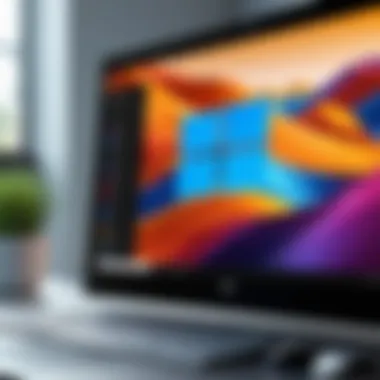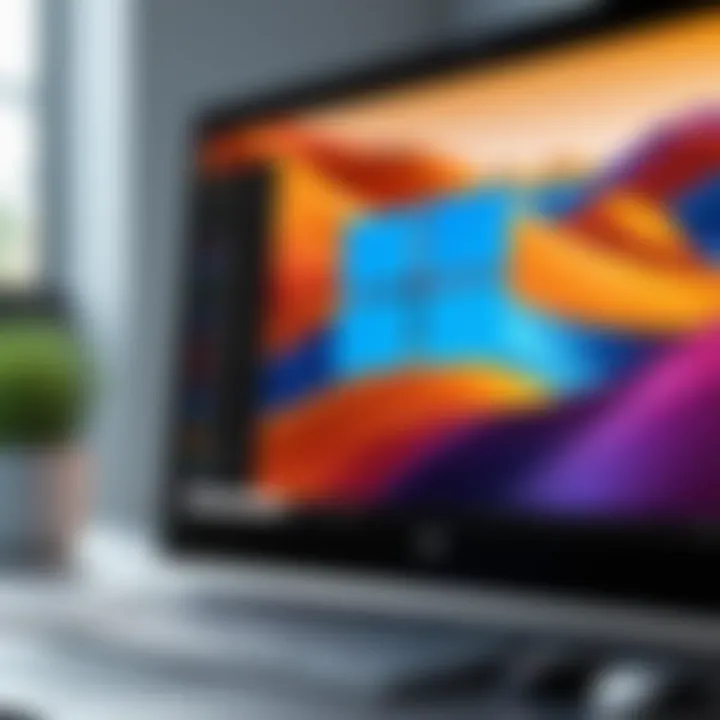Exploring the Features and Programs of Windows 11


Intro
With the rise of remote work and the demand for more powerful computing solutions, Windows 11 has stepped into the spotlight. This new operating system is more than just a pretty face; it boasts a range of programs and features aimed at improving user experience and productivity. From redesigned interfaces to cutting-edge security measures, Windows 11 is tailored for today's tech-savvy individuals and gadget enthusiasts.
As we embark on this exploration, we’ll peel back the layers of Windows 11. You’ll learn about its key features, how it enhances performance, and ways to maximize its potential.
Product Overview
Key Features
Windows 11 introduces a host of functionalities that make it stand out. Here are some highlights:
- Revamped Start Menu: The new centered Start Menu feels more intuitive. It's easier to access your apps and documents.
- Snap Layouts: Multitasking is a breeze with Snap Layouts, allowing you to organize open applications efficiently without clutter.
- Widgets: Personalized widgets give you quick access to news, weather, and other essential information at a glance.
- Microsoft Teams Integration: Seamless integration with Microsoft Teams promotes effortless communication, making it ideal for remote work.
- Enhanced Gaming Features: For gamers, DirectStorage technology helps load games faster, enhancing the overall gaming experience.
These features solidify Windows 11 as not just an upgrade but a leap towards an integrated digital workspace.
Specifications
Understanding the specifications underlying Windows 11 is crucial:
- System Requirements: Windows 11 has specific hardware demands – a compatible 64-bit processor, 4 GB RAM, and 64 GB storage are essential.
- Compatibility: It runs on devices that support Tpm 2.0 for added security, ensuring that your data stays protected.
- User Interface: The OS sports a sleek design with rounded corners, a fluid interface, and visually pleasing animations that provide a refreshing feel.
Performance Analysis
Speed and Efficiency
With Windows 11, speed and efficiency take the front seat. Boot times are noticeably shorter, and applications launch with remarkable swiftness. The task manager is finely tuned for resource management, allowing users to maximize their efficiency by monitoring and controlling what apps use the most resources.
Battery Life
Battery life improvements can’t be overlooked either. Windows 11 takes advantage of new power management technologies to extend battery life, especially on laptops. The OS optimizes background activity and scales down resources for apps that aren’t in use, ensuring that you get more bang for your buck.
"Windows 11 not only looks good but also runs like a finely-tuned machine, ready to tackle the needs of modern users."
As we unravel these features and enhancements, it's essential to see how they interact with each other in creating a more efficient computing environment. Moving beyond just specifications, the true testament of Windows 11 lies in how these elements come together to forge a streamlined experience.
Foreword to Windows
Understanding Windows 11 is vital for anyone looking to harness the power of modern computing. This new operating system from Microsoft introduces a host of features that not only modernize the user experience but also enhance productivity. As we delve into the various elements, it becomes clear that Windows 11 is crafted with both aesthetic and functional improvements. These changes aim to keep the user engaged while also offering tools that streamline daily tasks.
Windows 11 redefines how we interact with our devices. From its redesigned interface to the integration of advanced features, the OS is designed for efficiency. Adopting this operating system isn't just about having the latest software; it’s a commitment to maximizing your computing power. The benefits of understanding Windows 11 span from improved security to innovative productivity tools, all aimed at making the user’s life easier.
Moreover, the installation of Windows 11 has specific system requirements that users must be aware of. Ensuring your device meets these prerequisites is essential for a smooth transition. By exploring Windows 11’s workings, one can tailor their computing experience to their personal or professional needs.
"Innovation distinguishes between a leader and a follower." — Steve Jobs
This article lays the groundwork for understanding Windows 11 by first examining its foundational aspects, followed by a detailed look into its core programs and features, ultimately empowering users to make the most out of their experience.
Overview of Windows
Windows 11 presents a fresh perspective on how an operating system can enhance user experience. Unlike its predecessor, which had become somewhat cluttered, Windows 11 boasts a clean and minimalist interface. The Start Menu sits in the center of the taskbar, creating a more balanced layout, while the rounded corners and softer edges provide a modern touch.
The operating system is built with an emphasis on usability and accessibility. Furthermore, new features like Snap Layouts streamline multitasking, allowing users to manage multiple applications simultaneously with ease. Overall, Windows 11 is more than just an upgrade; it's a rethinking of how technology can facilitate everyday tasks for a variety of users.
System Requirements
To fully utilize Windows 11, it's key that users check their system against the requirements set forth by Microsoft. Getting started on the right foot ensures that you won’t run into hiccups that hinder performance or functionality. Here’s a brief list of essential hardware requirements for Windows 11:
- Processor: 1 GHz or faster with at least 2 cores on a compatible 64-bit processor or SoC.
- RAM: 4 GB or more.
- Storage: 64 GB or larger storage device.
- System Firmware: UEFI, Secure Boot capable.
- TPM: Trusted Platform Module (TPM) version 2.0.
- Graphics Card: DirectX 12 compatible graphics / WDDM 2.x.
- Display: > 9" with HD Resolution (720p).
Meeting these specifications is vital to unlocking the full potential of Windows 11. For users running older machines, this may require hardware upgrades or a new device altogether. Nonetheless, investing in compatible hardware positions users to take full advantage of the enhanced features and overall performance improvements offered by Windows 11.
User Interface Enhancements
User Interface Enhancements play a vital role in how users interact with Windows 11. It's not just about aesthetics; these improvements have a serious impact on daily productivity. A streamlined interface can help users perform tasks more efficiently, reducing the frustration that often comes with complex navigation. Key elements in the interface include clarity, accessibility, and personalization. Watching how these aspects blend together forms the crux of a more pleasant computing experience.
Start Menu Redesign
The Start Menu in Windows 11 has undergone a significant facelift. Gone is the traditional layout, replaced with a fresh, centered arrangement. The new Start Menu simplifies access to applications while using a tile system that allows for more personalized experiences. This update reflects a shift towards user-friendliness, encouraging users to customize their digital space according to their workflow. Quick access to recent documents and apps makes it easier to jump back into tasks without wrestling with menus.
Practicality and aesthetics drive the redesign, making it easier for users to find what they need without digging through layers of options. Furthermore, the incorporation of widgets allows users to pull information at a glance, streamlining productivity even further.
Taskbar Modifications
Taskbar Modifications are another highlight in Windows 11. The centered icons can seem a bit jarring at first, especially for longtime users, but they create a more cohesive appearance across the desktop landscape. Users can pin essential applications for quick access, which means less time spent searching through menus.
The addition of a revamped notification system enhances the taskbar, giving users a clearer overview of their alerts. The new approach encourages users to stay organized and maintain focus, reducing distractions from notifications that scatter across the screen.
Virtual Desktops
Virtual Desktops introduce a more organized workspace by allowing users to compartmentalize their activities. This feature is especially beneficial for those juggling multiple projects or tasks, offering a digital landscape where users can switch between different sets of applications.


Creating Multiple Desktops
Creating Multiple Desktops is a standout feature of Windows 11. Users can craft personalized desktops tailored to specific needs, whether for work, leisure, or anything in between. With just a swipe or click, switching between these desktops is a breeze. This means every project can have its own dedicated space—sort of like having different rooms for different purposes.
The beauty of Creating Multiple Desktops lies in its simplicity and flexibility. However, some may find that managing too many desktops can become overwhelming. Users must strike a balance; too much variation might clutter the experience rather than enhance it.
Managing Virtual Desktops
Managing Virtual Desktops takes the organization further. Users have tools at their disposal to rearrange, rename, or close desktops with relative ease. This helps users maintain control over their workflow. By actively managing their virtual spaces, users feel less like they are drowning in tasks.
The key characteristic of Managing Virtual Desktops lies in its user-friendliness. It’s all about adapting to each user's lifestyle, offering unique features that cater to diverse workflows. However, as with Creating Multiple Desktops, there can be pitfalls. Users should regularly review their desktops to ensure they are serving their intended purposes rather than becoming another layer of complexity in an already busy cognitive load.
"Navigating through Windows 11 feels more like dancing across a digital canvas, rather than sifting through a messy intervention."
In wrapping up this section, the enhancements to the user interface in Windows 11 aim at elevating the user experience, reflecting a deeper understanding of what users need in their computing environments. With improvements in the Start Menu, taskbar, and virtual desktop management, Windows 11 positions itself as a tool for not just productivity but also creativity.
Core Programs in Windows
Windows 11 houses an array of core programs that substantiate its reputation as a sophisticated operating system. These programs are pivotal, enhancing how users interact with their devices. By streamlining processes such as file navigation, web surfing, and system configurations, Windows 11 emphasizes efficiency and productivity. The core programs not only cater to essential functions but also enrich the overall user experience, making routine tasks less cumbersome and more intuitive.
File Explorer Improvements
The File Explorer in Windows 11 underwent substantial enhancements that primarily revolve around improving accessibility and user experience. These advancements affirm its importance in ensuring users can navigate their files with adeptness.
New Navigation Features
The new navigation features in File Explorer focus on elevating the ease with which users can locate their files. For instance, the refreshed layout includes a new command bar that centralizes tools and functions, allowing for streamlined actions without clutter. A particularly noteworthy trait of this feature is the updated Quick Access section, now showcasing files and folders you frequent, putting them at your fingertips.
Why is this beneficial? It minimizes time spent hunting for files and instead allows users to focus on their productivity, which aligns seamlessly with the overall goals of Windows 11. The unique feature here is the ability to pin crucial folders right at the top of the navigation pane, ensuring immediate access. However, a slight disadvantage might be the learning curve for long-time users accustomed to the previous version of File Explorer, but once familiar, the advantages far outweigh this initial hurdle.
Enhanced File Management
Enhanced file management is another hallmark of Windows 11’s File Explorer improvements. New sorting and grouping options provide users with much better ways to organize files according to their preferences. The introduction of a new details pane offers a quick view of file properties without demanding the user redirect to another window.
A key characteristic of this feature is the ease with which one can perform bulk actions, such as renaming a group of files simultaneously. This can be a time-saver, particularly for users who deal with large volumes of data. The unique ability to create tabs within File Explorer is a game changer, allowing users to juggle between different directories seamlessly without losing their place. While this feature is overall beneficial, some users might find it a bit overwhelming at first due to the increased options available.
Microsoft Edge Integration
With Windows 11, Microsoft Edge has become more intimately integrated into the operating system. This transition underscores the emphasis on security and performance. With built-in features like vertical tabs and enhanced privacy controls, this browser isn’t just about speed, but also about creating a safer online environment. Beyond mere browsing, Edge now serves as a portal for accessing applications straight from the browser, which could be increasingly advantageous for users looking to consolidate their workspace.
Settings Application
The Settings application in Windows 11 showcases marked improvements that add significant value to user interaction. The revamped navigation and layout make it more intelligible, facilitating processes that were once buried beneath layers of menus.
New Layout and Features
The new layout significantly enhances usability by categorizing settings into digestible sections. For instance, all system settings are now easily accessible under a primary umbrella, which reduces the frustration of retrieving specific options. A key characteristic of this new layout is the search functionality that allows users to find what they need in a snap.
This focus on intuitive navigation underlines why it’s a favorable choice for users seeking to efficiently customize their systems. In addition, the fresh dark mode filter adds an aesthetic touch and is easy on the eyes, particularly in low light conditions. Notably, the downside is that some users might take time to adjust to the new categorization, but with practice, it usually leads to a more efficient interaction.
Accessibility Options
Windows 11 places a strong emphasis on inclusivity through its accessibility options. The settings application enables users to adjust their displays, increase text size, and even utilize text-to-speech functions. This is of paramount importance as it allows everyone, regardless of their abilities, to use their devices effectively.
A key trait of these options is their flexibility; users can customize their experiences to suit their specific needs. The unique feature of voice typing significantly enhances the productivity of users who prefer speaking over typing. While the myriad of options can seem daunting at first, the empowerment it offers makes it an invaluable resource in the Windows 11 arsenal.
Productivity Tools
In today’s fast-paced digital landscape, efficiency in our workspaces is more than just a luxury—it’s a necessity. Windows 11 recognizes this and introduces productivity tools that are designed to streamline tasks, enhance focus, and curate information at a glance. These tools are aimed at simplifying multitasking while ensuring that users can concentrate on their priority tasks without unnecessary distractions. Let’s take a closer look at the distinct features that make these productivity tools invaluable.
Snap Layouts and Snap Groups
The Snap Layouts and Snap Groups feature is a game-changer for anyone juggling multiple windows and applications simultaneously. With Snap Layouts, you can quickly arrange your open windows into predefined layouts. This means you can split your screen to show two, three, or even four applications side by side, depending on what you need at any moment.
Key characteristics include:
- Ease of Use: Just hover over the maximize button of any window, and you’ll see available snap options pop up. This intuitive design makes it a breeze to organize your workspace without the fuss.
- Efficiency in Multitasking: Snap Groups remembers the layout! This means, if you switch applications or minimize them momentarily, you can restore your previous arrangement without having to think about it.
Focus Assist
Focus Assist is a standout tool designed with the modern worker in mind. It helps to minimize distractions when you’re deep into a project or need moments of focused work. You can customize it to enable notifications only for select apps or contacts while silencing everything else.
Why Focus Assist is effective:
- Customizable Settings: Users can adjust Focus Assist to activate automatically during certain hours or during events on their calendars, ensuring that notifications don’t interrupt crucial work.
- Automatic Scheduling: When you start a meeting on your calendar, Focus Assist can automatically kick in, providing you a distraction-free zone. This thoughtful feature can significantly push productivity upwards.
Widgets Feature
Widgets in Windows 11 present a contemporary twist to customized information delivery. This feature enables you to create a board for your most relevant updates, news, weather, calendar, and more, all in one accessible spot.
Customization Options


Widgets provide users with a range of customization options, allowing you to tailor what you see on your dashboard. From choosing which news topics to display to adjusting the size and arrangement of each widget, the flexibility it offers is considerable.
Why these options matter:
- Personalized Experience: Each user can curate their widgets based on interests, which means the information presented aligns well with individual needs and priorities, subsequently enhancing the relevance and utility.
- Dynamic Updates: Widgets refresh automatically, ensuring that the information displayed is up-to-date, which is essential in today’s fast-paced environment.
Information Display
The information display in widgets is designed to provide a quick glance at essential updates without overwhelming the user. The display uses a clean layout, so users can easily glean important information at a moment’s notice.
Advantages of this display:
- Simplicity: The uncluttered design aids in focus rather than distraction, allowing you to quickly review important news, weather forecasts, and calendar items with just a look.
- Concise Information Access: Key events and alerts are highlighted to ensure nothing crucial escapes your notice.
Productivity tools are not just add-ons; they are part and parcel of an efficient Windows 11 experience. Understanding how to utilize them effectively can greatly enhance your productivity.
Incorporating these tools into your daily routine can lead to significant time savings and manageability of your digital environment. The tools in Windows 11 aren’t merely enhancements; they represent a leap towards an improved user experience. By familiarizing yourself with Snap Layouts, Focus Assist, and Widgets, you maximize your operational efficiency in truly a modern workspace.
Performance Enhancements
Performance enhancements in Windows 11 play a crucial role in ensuring that users can fully leverage their hardware capabilities while maintaining an efficient workflow. By focusing on speed and operational efficiency, Windows 11 aims to provide a smoother user experience and address the demands of both casual users and tech enthusiasts. The operating system is designed to optimize resource usage and deliver faster execution times, all of which lead to a more productive environment.
Speed and Efficiency Improvements
One of the standout features of Windows 11 is its ability to boot up and run applications faster than previous versions. Starting from the moment you power on your device, you’ll notice that this OS is snappier, reducing your wait time significantly.
- Startup Performance: Windows 11 optimizes startup sequences, taking advantage of features such as Modern Standby which allows a quick resume from sleep mode. This means less downtime when you need to get to your tasks.
- Memory Management: Another noteworthy aspect is improved memory management. Windows 11 prioritizes foreground applications while minimizing resource allocation for background processes. This results in applications running quickly without unnecessary interruptions.
With these enhancements, not only do users get smoother performance, but they also experience less frustration during multitasking.
Gaming Features
Windows 11 brings a fresh coat of paint to gaming with features aimed specifically at enhancing the overall experience for gamers.
DirectStorage
DirectStorage is a game-changing feature that extends the capabilities of storage drives specifically for gaming. It streamlines data delivery by allowing games to load directly from the SSD to the GPU, bypassing the CPU. This unique approach significantly reduces loading times for games, which is a huge win for gamers with SSDs.
- Key Characteristic: The prime characteristic of DirectStorage is its ability to manage game assets more efficiently. This means that massive worlds and rich environments can load instantly, delivering a seamless experience without lag.
- Benefits: With DirectStorage, the performance of games is heightened, leading to immersive experiences that were previously hard to achieve. The reduction in loading screens allows players to plunge right into the action. This feature holds particular appeal for those who cherish quick access and minimal interruptions during gameplay.
Auto HDR
Auto HDR is another highlight that Windows 11 brings to the table. This feature automatically applies High Dynamic Range (HDR) enhancements to games that were not originally designed for HDR. The results can be striking, showcasing deeper blacks and brighter highlights, enriching the visual experience.
- Key Characteristic: The notable characteristic of Auto HDR is its ability to adapt and enhance older titles with visual upgrades. Even games that don’t natively support HDR can benefit, bringing a new lease of life to classic games.
- Advantages: This feature effectively gives users a chance to play older games with modern visual fidelity. It’s noteworthy for players who value the aesthetic quality as part of their gaming experience.
Overall, the performance enhancements in Windows 11 cater to those who seek speed, efficiency, and a highly immersive gaming experience. Each feature works in harmony, enhancing overall satisfaction and productivity in both gaming and everyday tasks.
Security Features
When it comes to discussing the features of an operating system like Windows 11, one cannot overlook the critical aspect of security. In an age where cyber threats loom large, robust security features are not just a luxury; they are a necessity. As users increasingly transition to digital platforms for work, education, and personal tasks, the integrity of their data and the security of their systems become paramount. The enhancements in Windows 11 cater specifically to these needs, ensuring a fortified environment for all the activities users engage in.
Understanding the security features of Windows 11 isn't merely about knowing that they exist. It's about appreciating their role in safeguarding personal information, enhancing user trust, and ultimately providing peace of mind.
Windows Security Updates
Windows Security updates serve as the backbone of the security framework in Windows 11. These updates are not just routine patches; they are essential for counteracting emerging threats. Each update is meticulously constructed to address vulnerabilities that have been discovered since the last version was released. As such, keeping the system up to date is critical.
- Timely Releases: Microsoft frequently rolls out updates that tackle various aspects of security, ensuring users are protected against the latest in cyber threats.
- User Control: Users have the option to control when updates are installed, which can be crucial for those who need to maintain system stability during critical tasks.
Regularly updating Windows Security not only shields the system from malware but also equips users with enhanced features. For instance, the anti-virus tool includes real-time protection that detects harmful applications before they take root.
"Staying vigilant with updates is the first line of defense against potential breaches."
BitLocker Enhancements
Continuing on the topic of security, BitLocker stands out as one of the most powerful tools offered by Windows 11. This full-disk encryption feature is designed to protect user data by rendering it unreadable without proper authentication. Its importance can’t be overstated in today's world, particularly where data breaches make headlines almost daily.
One of the notable enhancements in Windows 11 related to BitLocker includes:
- Improved User Interface: The user experience has been streamlined, making it easier for even less tech-savvy individuals to enable encryption without feeling lost.
- Recovery Options: The recovery keys are stored more securely and can be retrieved with ease when needed, which is crucial if you ever find yourself locked out of your own files.
In practical terms, enabling BitLocker can become vital for users who work frequently with sensitive information. Imagine having critical documents on a laptop that is lost or stolen; without BitLocker, the chances of unauthorized access increase immensely. However, with proper encryption, the data becomes a locked vault, accessible only to those who hold the right key.
In summary, the security features in Windows 11, from frequent security updates to enhancements in BitLocker, provide essential layers of protection that empower users. Ignoring these tools not only jeopardizes personal information but could also result in significant setbacks in both personal and professional environments.
Managing Apps and Programs
Managing applications and programs in Windows 11 is a cornerstone of maintaining not only functionality but also user satisfaction. It’s easy to overlook how pivotal this aspect is until you find a clunky program slowing down your system or unintentionally create file conflicts due to unmonitored installations. A well-managed software environment means smoother operation and a more tailored experience.
Installing and Uninstalling Programs


The process of installing and uninstalling programs is simpler than many users might think. Windows 11 streamlines this with an upgraded interface, making it more intuitive. When it comes to installing, users either download applications directly from the web or use the Microsoft Store. The latter is perhaps the safer route, ensuring that applications meet certain security standards, which is often highlighted in user discussions on platforms like Reddit.
Uninstalling is made easier too; gone are the days of digging through control panels with all their labyrinthine settings. One can now easily remove programs by accessing Settings > Apps > Apps & features, where a simple click takes care of the heavy lifting. This not only declutters the system but also helps in reclaiming precious bandwidth and storage space.
Using Microsoft Store
One of the most significant improvements in Windows 11 revolves around the Microsoft Store, an integrated hub that offers a plethora of applications tailored for various needs. Accessing this store is straightforward; a few clicks, and you're welcomed by an array of options designed to enhance your computing experience.
Finding Applications
Finding applications through the Microsoft Store is quite the breeze. The store hosts an organized collection that ranges from casual games to serious productivity tools. The search functionality is robust, allowing users to filter by category, user rating, and compatibility. This organization is truly a key characteristic since it minimizes the frustrating experience of sifting through numerous applications.
Additionally, many users appreciate the relevant user reviews and ratings available. These insights are invaluable when determining if a specific application is right for their needs, as they speak volumes about the user experience. Though not every application is available on the store, this curated approach significantly reduces the risk associated with downloading from less known sources online.
Managing Updates
Keeping applications updated is another critical aspect of effective app management on Windows 11. Managing updates swiftly contributes to system stability and security. The Microsoft Store offers a one-stop-shop for checking for updates on all installed applications. Users can control their update preferences, balancing between automatic updates or manual checks.
This flexibility is a standout feature. While automatic updates ensure that users won't miss important security patches or enhancements, manual checks allow for a more hands-on approach which some tech-savvy individuals may prefer. There exists a balance here; however, one should be cautious of over-managing updates, as this may lead to inadvertently missing out on essential features or fixes.
"Management is not just about checking boxes, it's about sustainable growth and improvement in your digital environment."
Customization Options
In the realm of operating systems, customization options stand out as a critical feature. For users of Windows 11, these options allow for individual expression and streamline daily tasks. The beauty of customization lies not just in aesthetics but in enhancing usability to better fit personal workflows. Whether it’s altering backgrounds or adjusting settings, every modification presents an opportunity for users to create a tailored computing environment.
Themes and Backgrounds
Themes and backgrounds play a vital role in how users interact with Windows 11. The operating system offers a variety of built-in themes, but the real power lies in being able to create and modify one’s own. Users can choose color schemes that resonate with their personalities or moods—much like dressing for the day.
When it comes to backgrounds, Windows 11 allows for both static images and dynamic wallpapers that can evoke different feelings throughout the day. For instance, a serene nature scene might provide a calming presence during stressful tasks, while vibrant abstract designs could inspire creativity during brainstorming sessions. Changing these elements is simple and can be done in a few clicks within the Settings app. Not only does this foster a sense of ownership, but it can also significantly improve focus and productivity. A well-chosen theme often has a surprising impact on a user's mindset while working.
"Customization is not just about personal preference; it’s about crafting an environment that promotes efficiency and engagement."
Personalization Settings
Personalization settings further enhance this customized experience. Windows 11 provides the flexibility to tweak numerous aspects of the interface. For example, users can adjust the taskbar position, modify the size of icons, and even select the behavior of the Start menu. These settings allow users to prioritize the tools and information that are most relevant to their work.
Additionally, options such as text size and display scaling are critical for accessibility. Not everyone sees the same way, and accommodating different visual needs is paramount. Ensuring that text is easy to read can reduce strain and improve the overall experience.
For those who like to stay organized, grouping similar applications or using virtual desktops in conjunction with personalization settings can create an efficient workspace. Each revision in settings is an invitation to refine the user experience, creating a seamless flow from one task to another.
In summary, the customization options in Windows 11 not only reflect the user’s identity but also contribute to increased productivity and comfort. As technology evolves, the importance of creating a personalized computing environment becomes ever more apparent.
Troubleshooting Common Issues
In any operating system, navigating through hurdles can be a significant part of the user experience. Windows 11 is no exception. The ability to troubleshoot common issues not only enhances user satisfaction but also prolongs the life of the system. Understanding these challenges and knowing how to resolve them ensures that the experience remains seamless and efficient. Whether dealing with software crashes or connectivity problems, having a grasp of troubleshooting methods empowers users to tackle issues head-on.
Identifying Errors
Errors in Windows 11 can often arise unexpectedly, leaving users puzzled. Recognizing the signs of an error is the first step toward resolving it. Common indications include:
- Error Messages: Notifications that pop up during use can guide the user on the nature of the problem. For instance, a problem with a specific application often points to compatibility or updates issues.
- System Lag: Sudden slowdowns can hint at underlying issues, such as resource hogging by a particular program or potential hardware failures.
- Unexpected Shutdowns: If your device shuts down without warning, it might be time to investigate hardware health or power management settings.
Each issue may have its own root cause, and therefore, it’s essential to approach the identification process like a detective. The Event Viewer is a built-in tool that helps keep track of system events and can be an invaluable resource in detecting issues.
System Recovery Options
In cases where problems become too cumbersome to manage, Windows 11 offers several system recovery options that can restore functionality. Here’s a brief overview of these methods:
- System Restore: This feature allows users to roll back the system to a previous state, undoing recent changes that might have caused issues. Ideal for resolving conflicts after updates or new installations.
- Reset this PC: A more drastic approach, this option reinstalls Windows while preserving files or removing everything. It’s a crucial tool for those facing persistent stability issues or severe performance problems.
- Safe Mode: Booting in Safe Mode aids in diagnosing problems by starting Windows with a minimal set of drivers. This can help in identifying problematic software without the interference of other programs.
Utilizing these options can drastically reduce downtime and restore productivity.
"A stitch in time saves nine, as they say! Tackling issues early on can often prevent bigger headaches later."
Understanding how to approach the troubleshooting landscape of Windows 11 ensures users feel confident and equipped to handle any bumps in the road. With a firm grasp on identifying errors and knowing the recovery options available, users can maintain a smooth operating system experience.
Ending
In wrapping up our exploration of Windows 11's programs and features, it's essential to consider the significance of this topic in the context of computing today. The operating system presents not just a reboot of its predecessor but a carefully curated environment designed to foster productivity and user satisfaction. Acknowledging the myriad features at one's disposal can profoundly enhance interaction with technology, whether for work or leisure.
Summary of Key Features
Windows 11 is brimming with key features that elevate the user experience, some of which are:
- Revamped Start Menu: Unlike its predecessor, Windows 11 has a centered, minimalist Start Menu, providing a more organized way to access apps and documents. It's designed with a more user-friendly interface that minimizes clutter.
- Improved File Explorer: The enhancements in File Explorer, particularly the new navigation pane, allow for quicker accessibility of files. This is a game changer for those handling substantial amounts of data.
- Snap Layouts and Groups: The Snap features enable users to organize multiple windows seamlessly. This is particularly useful for multitasking, as one can easily switch between various tasks without losing track of open applications.
- Widgets: Instant access to personalized information like weather, news, or calendar events enhances productivity. It's a nifty addition for users who appreciate having quick data at their fingertips.
- Gaming Optimizations: Features like DirectStorage enhance load times and overall gaming performance, making Windows 11 a great choice for enthusiasts.
These key elements encapsulate the shift towards a more intuitive and engaging operating system, opening the door to efficiency in daily tasks.
Future Outlook for Windows
Looking ahead, Windows 11 is expected to continue its trajectory of innovation and improvement. Microsoft is committed to refining its operating system, which could lead to further enhancements in:
- Enhanced Integration of AI: As artificial intelligence becomes more integral to our digital lives, expect Microsoft to weave AI deeper into Windows 11, perhaps through smarter applications and improved automation features.
- Continued Updates: Microsoft has shown a willingness to respond to user feedback, suggesting future updates will address shortcomings more swiftly than in past iterations. This could mean more customization options and tailored support for a variety of hardware setups.
- Increased Cross-Device Functionality: With more people utilizing multiple devices, the potential for seamless transitioning and operation across devices is enormous. Future iterations may bring a more cohesive user experience whether on a PC, tablet, or smartphone.
- Focus on Security: With the increasing threat of cyber threats, advances in security features will likely be a top priority to ensure user data remains protected. Enhanced security measures could further solidify Windows 11 as a trusted platform.
Overall, as more users come onboard and feedback shapes the operating system, the future of Windows 11 promises an exciting evolution, adapting to the needs of today's tech landscape.



